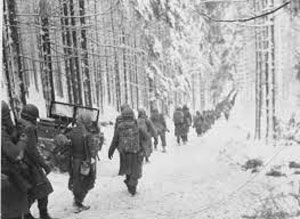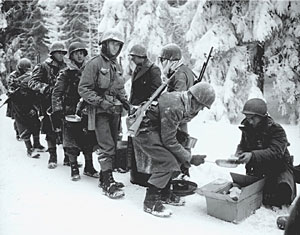
From December 16 of this month until January 28, 2020, veterans of the US Army and other Allies will honor those men who fought in the Battle of the Bulge, the last major battle in the European Theater. This year marks the 75th Anniversary of the Battle. Allies planned to invade Germany, eventually leading to the Nazi surrender and end of war in Europe. The Bulge slowed them down but did not defeat the Americans and Allies.
At dawn of December 16, 1944 American troops in the Ardennes region of Belgium, Luxembourg, and France awoke to an invasion by approximately 200,000 German soldiers. The weather was severely cold, around zero, knee deep snow slowed down marches to basically crawls, and food supplies were limited. Vehicles could not plow through the snow, leaving GIs to move on foot. Men cut blankets into strips to wrap around their feet. Survivors recall the large number of frozen bodies. Many who survived suffered from frozen feet, with or without amputations. But Americans and Allies fought on.
By Christmas the tide had turned in favor of the Allies, but the battle continued until January 25, 1945. Christmas Day was cold but sunny, allowing US planes to reinforce soldiers along the front. Some 19,000 troops died from cold, as well as the war. One of those young men was Carlton Sheram, a young Greenville man who had recently graduated from Texas A&M. Sheram was tank commander who was killed near Bastogne, Belgium. Citizens of Bastogne consider Sheram a hero, even to this day.

A couple of ironies connect with the Battle of the Bulge. The Germans attacked on December 16 in the Ardennes Region. It was in those hills and along the rivers that much of World War I was fought. And the Allies made it across the German border all the way to Munich. The Allies in 1918 accepted an armistice before Germany was invaded and suffered any damage.
Soldiers from the Third United States Army carried a printed copy of Gen. George Patton’s Christmas Prayer of 1944. Patton had a copy given to each soldier before the battle. It petitioned the heavens for good weather and concluded with a Christmas greeting from the General. It read, “To each officer and soldier in the Third United States Army, I wish a Merry Christmas. I have full confidence in your courage, devotion to duty, and skill in battle. We march in our might to complete the victory. May God’s blessings rest upon each of you on this Christmas Day.”
This was Hitler’s last major offensive along the Western Front. Winston Churchill call it the “greatest American battle of the war”. It crushed Germany’s hope for ultimate success in the war.
